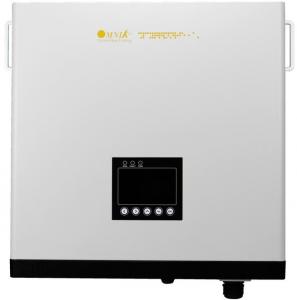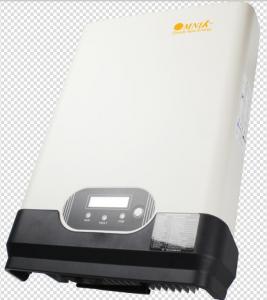Omniksol-1.5k-TL
- Loading Port:
- Shanghai
- Payment Terms:
- TT OR LC
- Min Order Qty:
- -
- Supply Capability:
- 3000 pc/month
OKorder Service Pledge
OKorder Financial Service
You Might Also Like
Omnik new energy solar inverter
Omniksol-2.0k-TL Photon Efficiency up to 3kW
in the world------ Photon tested Jan. 2012.
Omniksol-1.5k-TL
Futures
Transformerless design, high efficiency (Max.97.5%,Euro.96.6%)
High MPPT accuracy(>99.9%)
Wide DC input range(120-500 Vdc), compatible with different module technologies
Easy to wire, install and operate
IP 65 design, suitable for indoor and outdoor installation
5 years warranty(10~25 years as option)
technical data:
Type | Omniksol-1.0k-TL | Omniksol-1.5k-TL | Omniksol-2.0k-TL |
Max. PV-Generator Power [W] | 1300 | 1750 | 2300 |
Max. DC voltage [V] | 500 | 500 | 500 |
MPPT DC voltage Range [V] | 80-300 | 120 - 450 | 120 - 450 |
Turn off DC voltage [V] | 80 | 120 | 120 |
Max. DC Current [A] | 16 | 18 | 18 |
Nominal DC Current [A] | 8.5 | 14 | 16 |
Number of DC Connection | 1 | 1 | 1 |
DC-Connection | MC4 | MC4 | MC4 |
Number of MPP trackers Turn on Power [W] | 1 | 1 | 1 |
Turn on power(W) | 10 | 10 | 10 |
- Q:What is the role of a solar inverter in voltage support?
- The role of a solar inverter in voltage support is to convert the direct current (DC) generated by solar panels into alternating current (AC) that is compatible with the electrical grid. Additionally, it helps regulate the voltage levels to ensure a steady and consistent supply of electricity to the grid, thereby supporting voltage stability.
- Q:What is the role of a power management system in a solar inverter?
- The role of a power management system in a solar inverter is to efficiently manage the flow of electricity from the solar panels to the grid or the connected devices. It ensures that the power generated by the solar panels is optimized, regulated, and synchronized with the grid's requirements. The power management system helps in maintaining the stability and reliability of the solar inverter system by monitoring, controlling, and adjusting the power flow, voltage levels, and frequency to prevent overloading or underutilization of the solar energy.
- Q:How does a solar inverter handle variations in ambient temperature?
- A solar inverter is designed to handle variations in ambient temperature by incorporating temperature compensation algorithms. These algorithms adjust the inverter's performance parameters, such as voltage and frequency, based on temperature measurements. This ensures that the inverter operates optimally and efficiently across a wide range of temperature conditions, maintaining stable and reliable power conversion from the solar panels.
- Q:How is a solar inverter different from a regular inverter?
- A solar inverter is specifically designed to convert the DC (direct current) electricity generated by solar panels into AC (alternating current) electricity that can be used to power household appliances and be fed back into the grid. On the other hand, a regular inverter is generally used to convert DC power from batteries or other sources into AC power. Therefore, the main difference lies in their purpose and the source of the DC electricity they handle.
- Q:Can a solar inverter be connected to a computer or smartphone?
- Yes, a solar inverter can be connected to a computer or smartphone. Many modern solar inverters are equipped with built-in Wi-Fi or Bluetooth capabilities, allowing them to connect to local networks. This enables users to monitor and control their solar system's performance and settings conveniently through dedicated software applications or web interfaces on their computers or smartphones.
- Q:What is the difference between a PV inverter and a solar inverter?
- The main component of the inverter is the three-phase bridge converter. The main purpose of the grid-connected inverter is to change the power to DC and change the AC power. The main purpose is to improve the power quality (because the wind power generation is very large
- Q:What are the key factors affecting the installation process of a solar inverter?
- There are several key factors that can affect the installation process of a solar inverter. Some of these factors include the location and orientation of the solar panels, the distance between the panels and the inverter, the type and capacity of the inverter, the wiring and electrical connections, and the availability of appropriate mounting structures. Additionally, factors such as local regulations, building codes, and safety considerations also play a crucial role in the installation process of a solar inverter.
- Q:What is the maximum power output of a residential solar inverter?
- The maximum power output of a residential solar inverter typically ranges from 1 kilowatt (kW) to 10 kW, depending on the specific model and capacity of the system.
- Q:Can a solar inverter be used with a solar-powered cooling system?
- Yes, a solar inverter can be used with a solar-powered cooling system. The solar inverter converts the direct current (DC) generated by the solar panels into alternating current (AC) that can be used to power various electrical devices, including the cooling system. This allows for the efficient use of solar energy to run the cooling system, reducing reliance on grid electricity and promoting sustainability.
- Q:How does shading impact the performance of a solar inverter?
- Shading can significantly impact the performance of a solar inverter by reducing the overall energy production of the solar panels. When certain parts of the solar panel are shaded, it creates an imbalance in the current flow, resulting in a decrease in the energy output. This can lead to a decline in the overall efficiency and power generation of the solar inverter. To mitigate this issue, technologies like bypass diodes are used in solar panels to minimize the impact of shading and ensure optimal performance.
1. Manufacturer Overview |
|
|---|---|
| Location | |
| Year Established | |
| Annual Output Value | |
| Main Markets | |
| Company Certifications | |
2. Manufacturer Certificates |
|
|---|---|
| a) Certification Name | |
| Range | |
| Reference | |
| Validity Period | |
3. Manufacturer Capability |
|
|---|---|
| a)Trade Capacity | |
| Nearest Port | |
| Export Percentage | |
| No.of Employees in Trade Department | |
| Language Spoken: | |
| b)Factory Information | |
| Factory Size: | |
| No. of Production Lines | |
| Contract Manufacturing | |
| Product Price Range | |
Send your message to us
Omniksol-1.5k-TL
- Loading Port:
- Shanghai
- Payment Terms:
- TT OR LC
- Min Order Qty:
- -
- Supply Capability:
- 3000 pc/month
OKorder Service Pledge
OKorder Financial Service
Similar products
New products
Hot products
Related keywords































